The vast majority of the Earth’s oceans have yet to be fully explored, so we still don’t know exactly what kinds of frightening surprises it holds.
However, from what we have discovered so far, our largest planetary waters do contain quite a few scary creatures!
Read on to discover the 20 scariest things still lurking in the ocean today.
1. Fangtooth
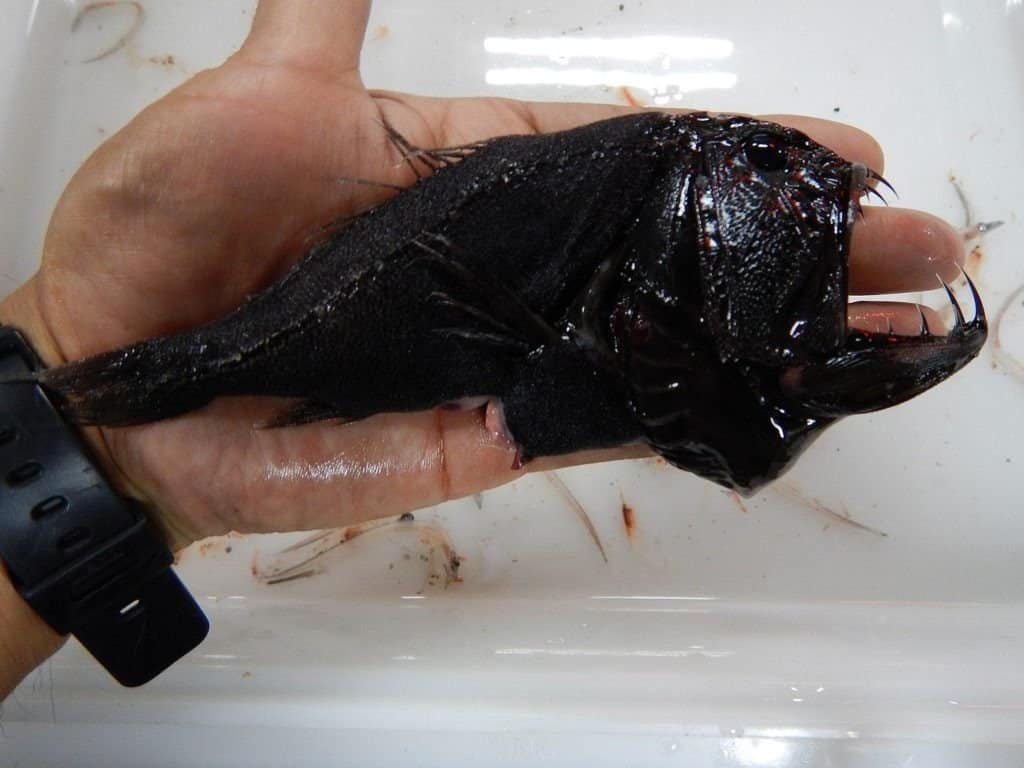
Photo of a trawler-caught fangtooth fish looking deceptively docile.
©NOAA Photo Library / CC BY 2.0, Flickr – License
What makes the 6-inch-long fangtooth (Anoplogastridae) scary is what you notice first: its long and sharp teeth that look like fangs you’d expect to see on a canine. These teeth, protruding from the upper and lower jaws, are truly terrifying! Adding to its strange looks are needle-like protrusions and spiky scales covering the fish’s body. Its extremely dark skin tones allow the Fangtooth to easily hide from predators. That’s because these colors absorb up to 99.5 percent of light, making the fish extremely hard to see.
The fangtooth stays at ocean depths of about 6,500 feet at night, but during the day swims up to a depth of about 1,600 feet to hunt.
2. Great White Shark
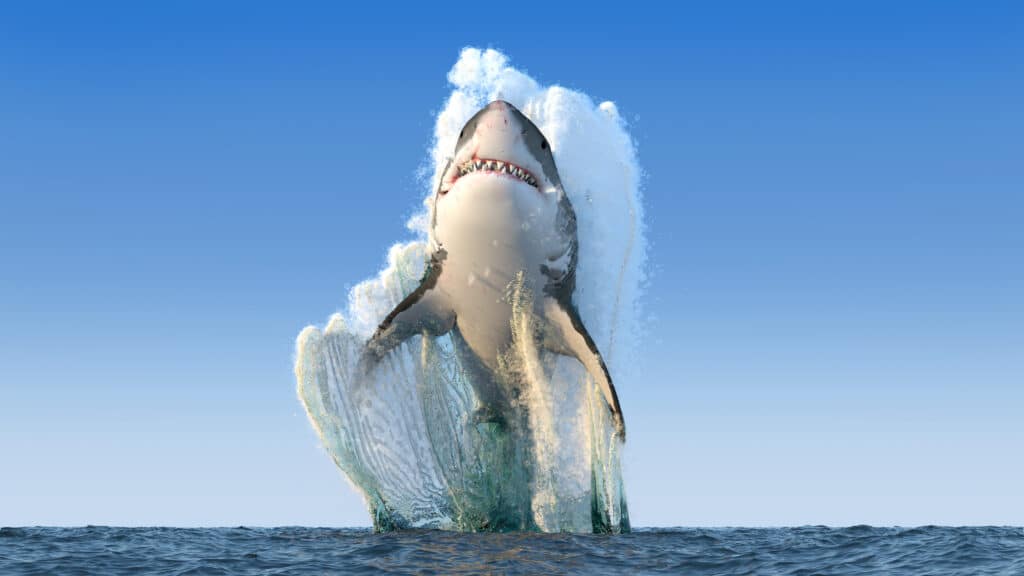
It’s never a dull moment in the ocean watching a “breaching”
great white shark
jump to the surface to catch prey.
©Alexyz3d/Shutterstock.com
The great white shark (Carcharodon carcharias) is a legendary gigantic fish of the seas. Its giant size is what makes people mistake it for a mammal. Surprisingly, it’s the female of this species that averages 15 -16 feet in length, as the male’s average length is just 11 -13 feet. Note that more scary 20-feet-long Great whites do exist! Worldwide, specimens live in the open ocean and coastal waters as cool as 54°F and as warm as 75°F.
When hungry, this shark is not picky about what’s on the menu. It prefers to eat everything from other sharks, stingrays, and seabirds, to large fish ceteceas, sea otters, and sea turtles. Humans are not the Great white’s natural prey. However, if you are chased by one, good luck in getting away. That’s because the typical human swims at a rate 10 times slower than this scary creature’s swimming speed, clocked at between 16 – 35 mph!
3. Giant Sea Spider
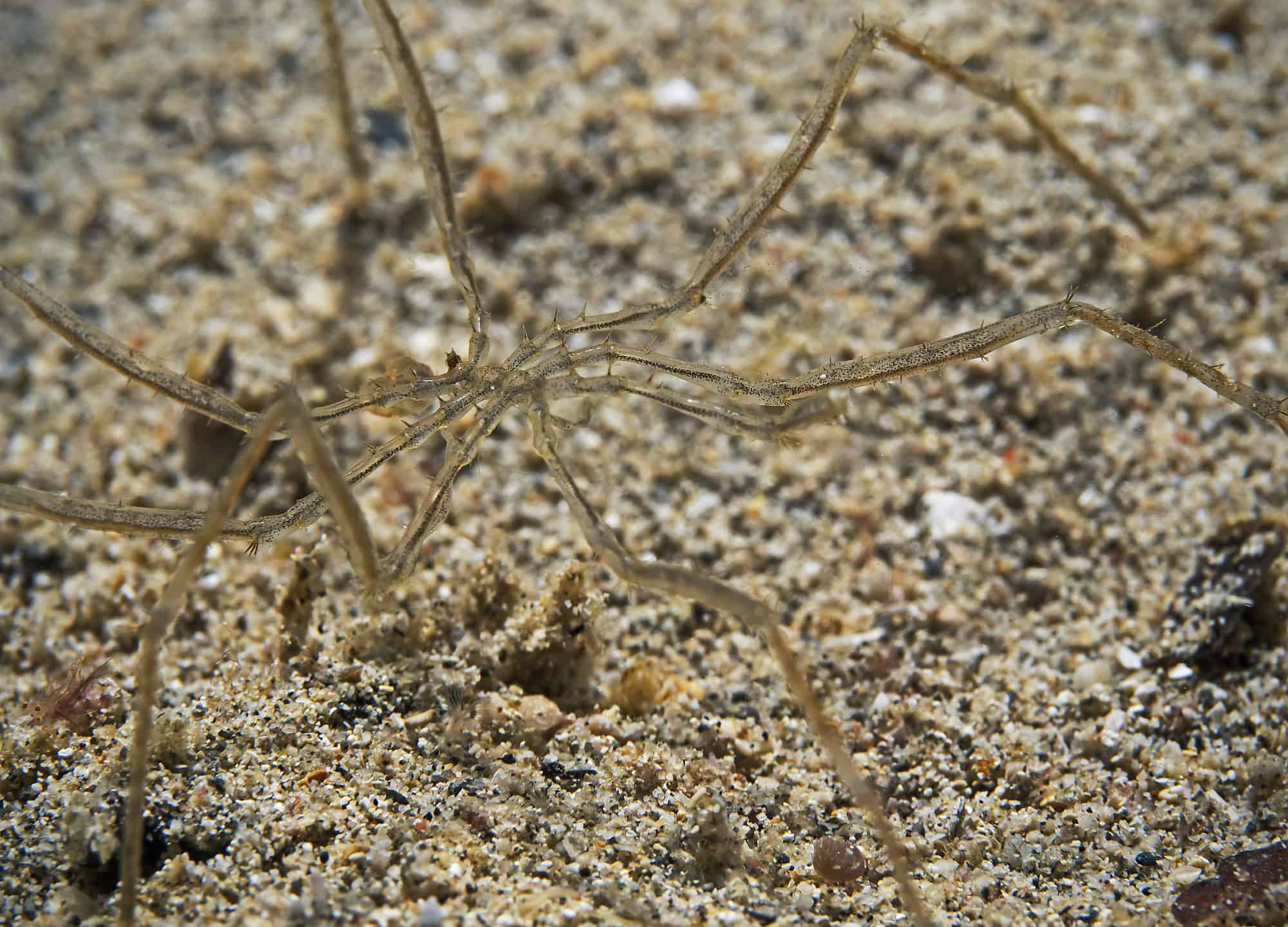
Underwater close-up of a sea spider, still growing to a giant size!
©iStock.com/scubaluna
If you’re afraid of land-based spiders, then the giant sea spider (Colossendeis colossea) will give you nightmares! Fortunately for you, this tiny predator prefers marine invertebrates over humans for food. After grabbing its prey, this scary thing will suck out the victim’s bodily fluids to get nourishment! Strangely, all its organs are located in its brains, including intestinal bags that allow it to breathe oxygen.
The giant sea spider’s eight long and crooked legs can grow 20 – 24 feet long! Typically the largest specimens live in ocean waters near Antarctica. This marine arthropod is not a real spider, but an animal more related to the horseshoe crab.
4. Barreleye Fish
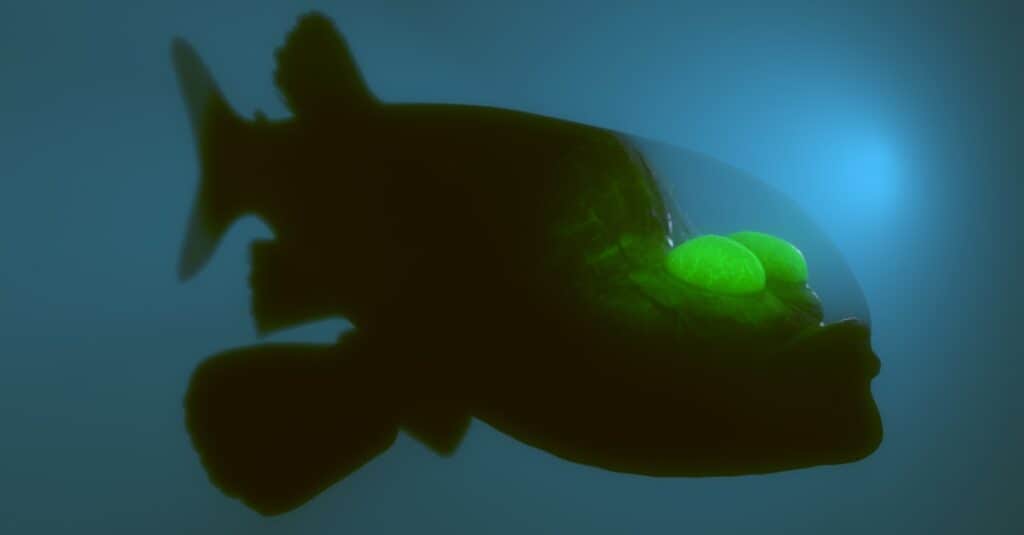
©iStock.com/3dsam79
A barreleye fish is on the hunt for its next meal, lighting up the ocean with bioluminescent eyes.
A deep-sea creature rarely seen, the 4-inch-long barreleye fish (Opisthoproctus soleatus) is well known for its transparent, fluid-filled head. That feature allows you to easily see its brains and other organs, The most striking thing about this fish is its bright-green “tubular” eyes that can rotate at will to look above or straight ahead. Creepy! The majority of the time, the barreleye fish keeps its eyes looking upward and uses its uniquely shaped fins to stay motionless in the deep ocean. Perhaps the little guy just enjoys a sedate, slow-moving life; or maybe is dreaming fishy dreams when at a standstill.
5. Portuguese Man O’ War
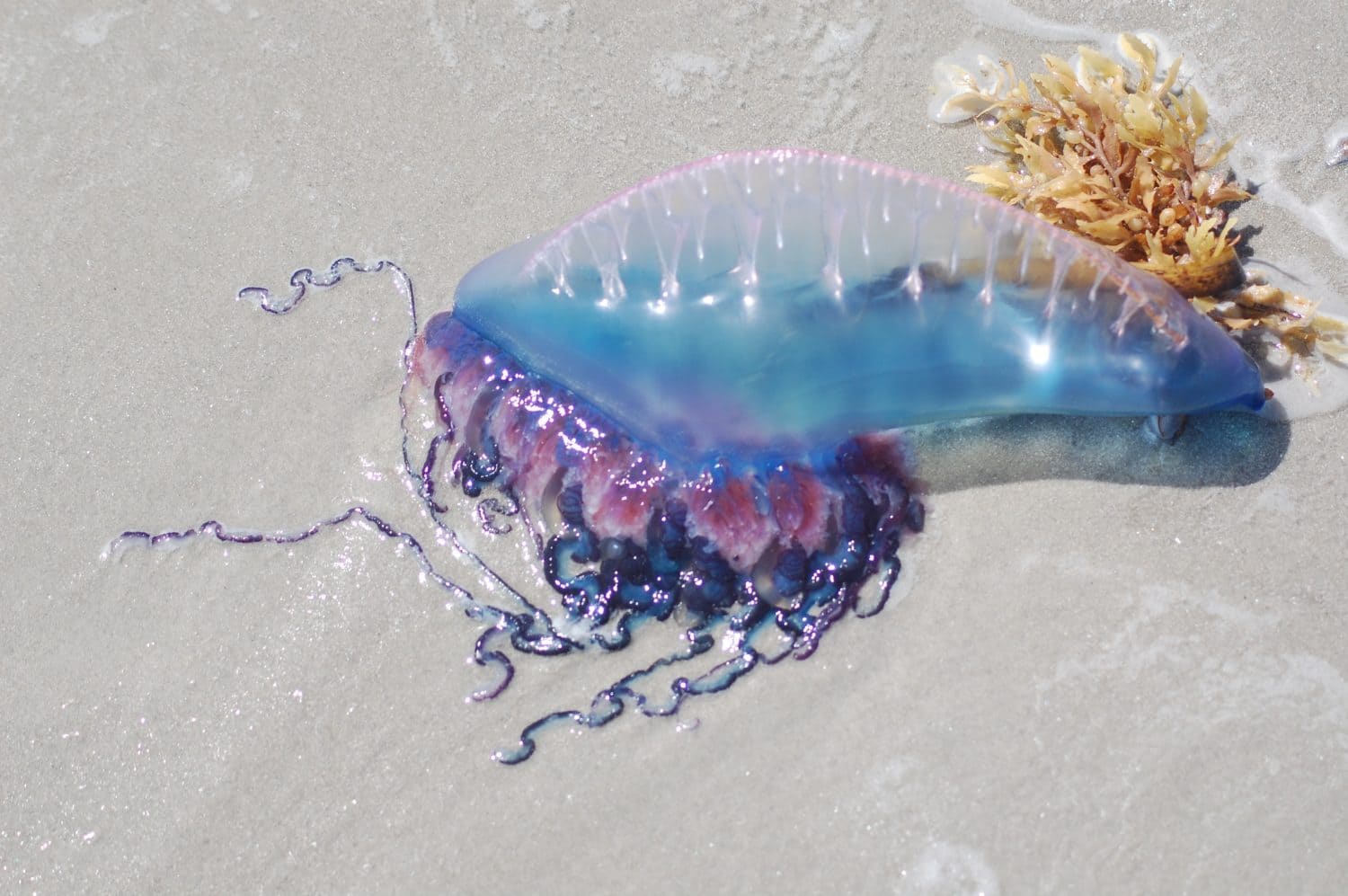
If you see a Portugese Man O’ War on the beach, don’t touch it! Its tentacles can release venom for days after the creature’s death.
©ortlerbr/Shutterstock.com
The Portuguese man o’ war (Physalia physalis) lives in all oceans but the Arctic. It doesn’t swim but moves with the wind thanks to its large gas bladder on top. The animal’s tentacles can be 30 to 100 feet long. However, one specimen had arms 165 feet long!
Not a jellyfish, this scary creature is a species of siphonophore, a group of organisms or colonies comprised of thousands of smaller “zooids.” Somehow they’re able to all look and act like an individual creature!
It’s not uncommon to see tens of thousands of them floating together searching for food. Once found, the man o’ war will wrap its powerful tentacles (featuring venom-filled barbs) around the prey, causing paralysis. Then, the food is brought inside its body for digestion.
Although a rare event, this predator can kill humans. Survivors say its sting is excruciatingly painful.
6. Brittle Star
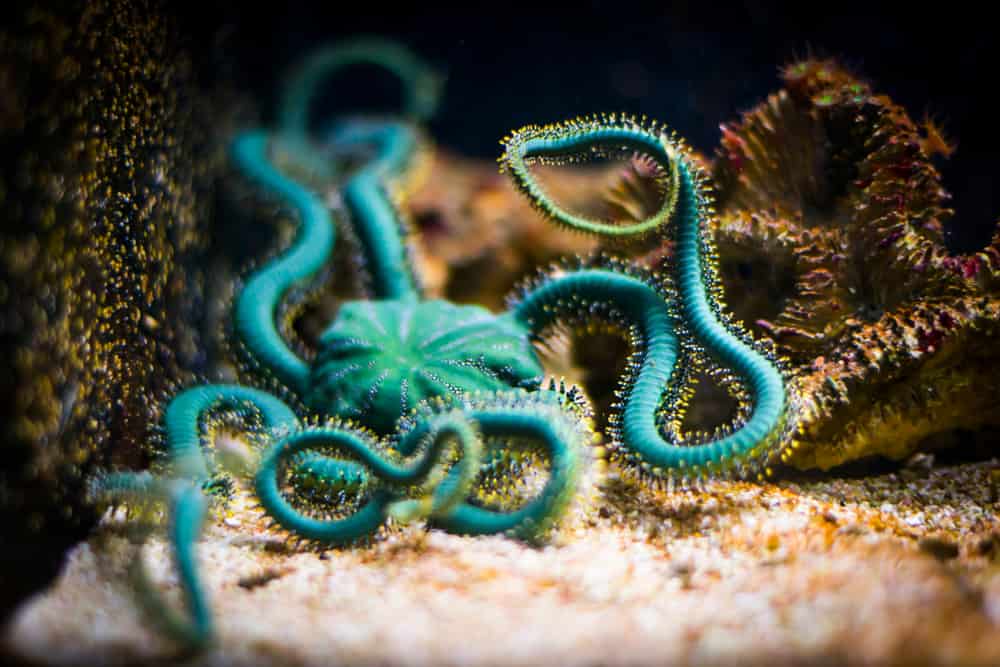
A turquoise brittle star slowly moves around in an aquarium.
©ewaplesna/Shutterstock.com
If you cringe at the sight of creepy centipedes, then you may find the brittle star (Ophiura ophiura) a bit of a scary thing! That’s because each of its five, long arms can look like those squirming and aggressive predatory arthropods.
7. Sarcastic Fringehead

Don’t let the cute fringe-like appendages fool you. The sarcastic fringehead is an aggressive little fish.
©Vibe Images/Shutterstock.com
The strange-looking sarcastic fringehead (Neoclinus blanchardi) lives in mud or sandy bottoms along California’s northern coast. It likes to ambush prey by jumping out to catch them when swimming Although small, Sarcastic Fringeheads are extremely aggressive. When feeling territorial, the 10-inch-long Fringehead becomes a scary creature to behold. It opens its mouth two times larger than its head and displays two rows of sharp teeth and a purple tongue.
Fun fact: After a female fringehead deposits her eggs inside a male’s home, she skips town forever. The male fringehead then becomes a defacto single father. He dutifully guards the little eggs from predators until baby fish hatch.
8. Faceless Cusk
Rarely seen, the faceless cusk (Typhlonus nasus) roams the deeper waters from Hawaii to the Arabian Sea. When caught, what surprises onlookers the most is its hard-to-find eyes set under the skin of a big, round head. This trait makes the eel-like cusk appear as if it doesn’t have a face! The fish’s mouth is difficult to find, too, as it’s located on the underside of the creature’s head.
9. Immortal Jellyfish

The immortal jellyfish has the weird ability to revert to a younger developmental stage!
©Rebecca Schreiner/Shutterstock.com
The tiny immortal jellyfish (Turritopsis dohrnii) is easily identifiable due to its bright-head innards inside a transparent spherical blob, and dozens of little wispy tentacles flaying out and about around its center. It has a scary secret that explains its unusual name. When this jellyfish dies and drops to the ocean floor, its decaying cells reform into tiny polyps. (The polyp is the third stage of its five-stage life cycle development.)
Amazingly, these polyps are clones of the original and grow into mature jellyfish if left alone. Therefore, astonished scientists studying the Immortal Jellyfish contend it can live decades, centuries, or possibly forever due to this remarkable biological process.
10. Saltwater Crocodile
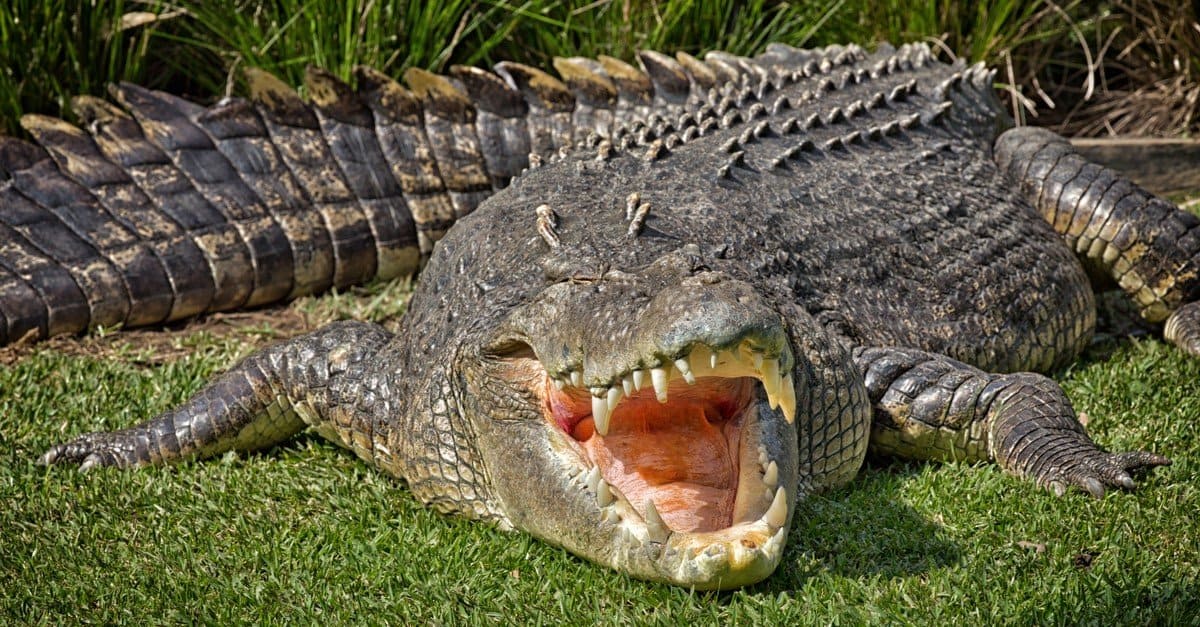
A huge saltwater
crocodile
basks in the hot Australian sun.
©PomInOz/Shutterstock.com
The saltwater crocodile (Crocodylus porosus) is the largest crocodile species in the world, and the biggest living reptile on our planet! These ambush predators can grow to 10 feet in length if female, and over 23 feet long if male. They kill about 1,000 humans a year (that we know of). All of these frightening specimens live mostly in the western Pacific and eastern Indian Oceans.
Birds are the closest living relatives to saltwater crocodiles and their cousins. They share common ancestors that roamed the Earth over 240 million years in the very distant past.
11. Blobfish
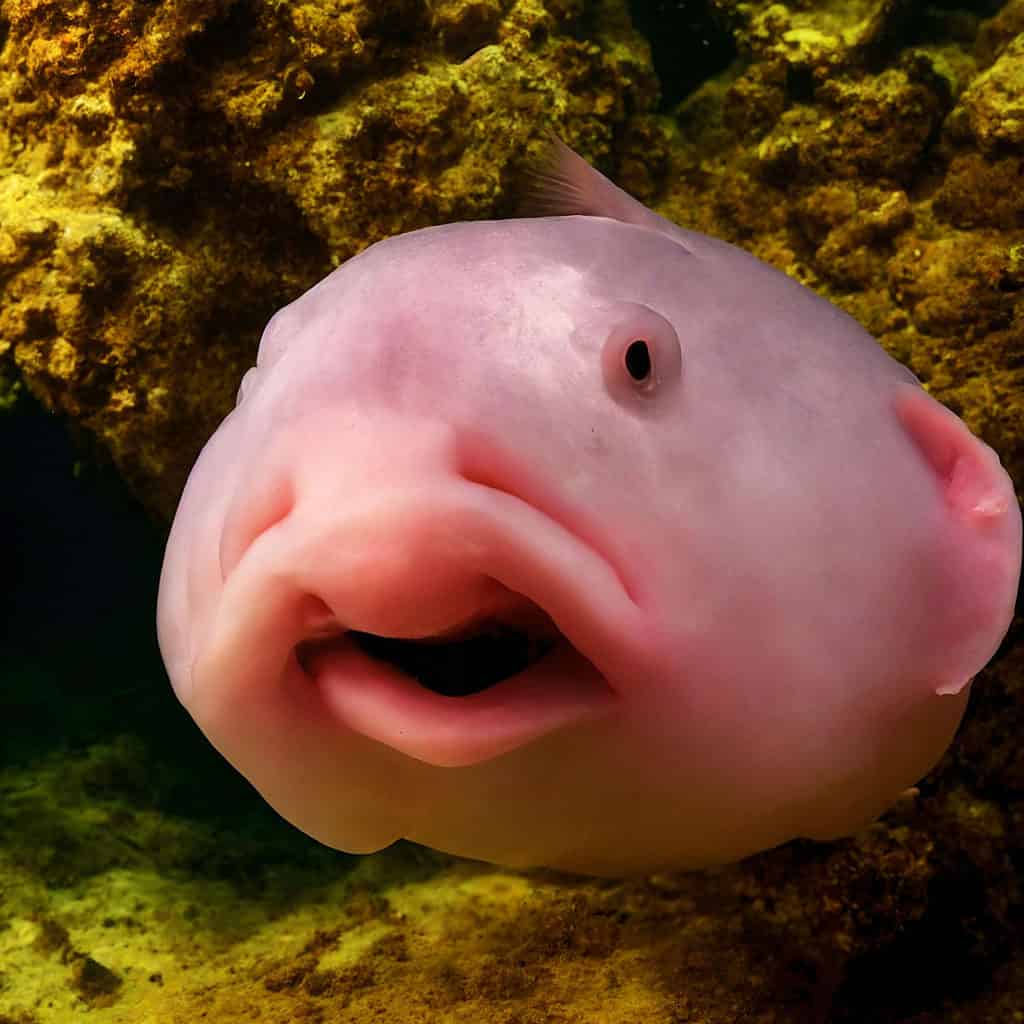
The
blobfish
is considered the ugliest animal alive; but isn’t beauty really in the eye of the beholder?
©World-Wide-Photography/Shutterstock.com
In 2013, global citizens voted the foot-long blobfish (Psychrolutidae) the “ugliest” animal on Earth. Some people say its clownish features also make this little guy scary. Perhaps the best Blobfish description comes from the U.S. National Oceanic and Atmospheric Administration: “[It] like a big, blobby tadpole, just a mass of pale, jelly-like flesh with puffy, loose skin, a big nose and beady, staring eyes.” Ugh!
12. Bobbit Worm

The scary-looking bobbit worm is known for its scissors-sharp pinchers and aggressive predatory hunting tactics.
©Xanth Huang/CC BY-SA 2.0 – License
The bobbit worm (Eunice aphroditois) can grow up to 10 feet long and looks like a sci-fi alien. But what’s more terrifying is how it hunts. The worm ambushes its food by patiently hiding under the sand. Once it detects something yummy swimming above, the worm moves at lightning speed to grab and pull down prey into the sand at speeds of up to 20 feet per second. The force of the worm’s mighty jaws, operating like heavy-duty scissors, is so strong that often it cuts its prey cleanly in half. This is why the bobbit worm in one of the scariest things still lurking in the ocean today!
13. Goblin Shark

The
goblin shark
is nicknamed “hobgoblin shark” in Spain and “imp shark” in France.
©Peter Halasz / CC BY-SA 3.0 – License
The Goblin Shark (Mitsukurina owstoni)) feeds on crustaceans and squid. But with nightmarish features such as an extra-long snout, and a big, curved mouth full of jagged teeth, it sure appears to be a man-eater! The shark typically grows 10 – 13 feet long and lives mostly near Japan. It’s named after goblins, the mythic evil creatures mentioned in Japanese folklore.
14. Anglerfish
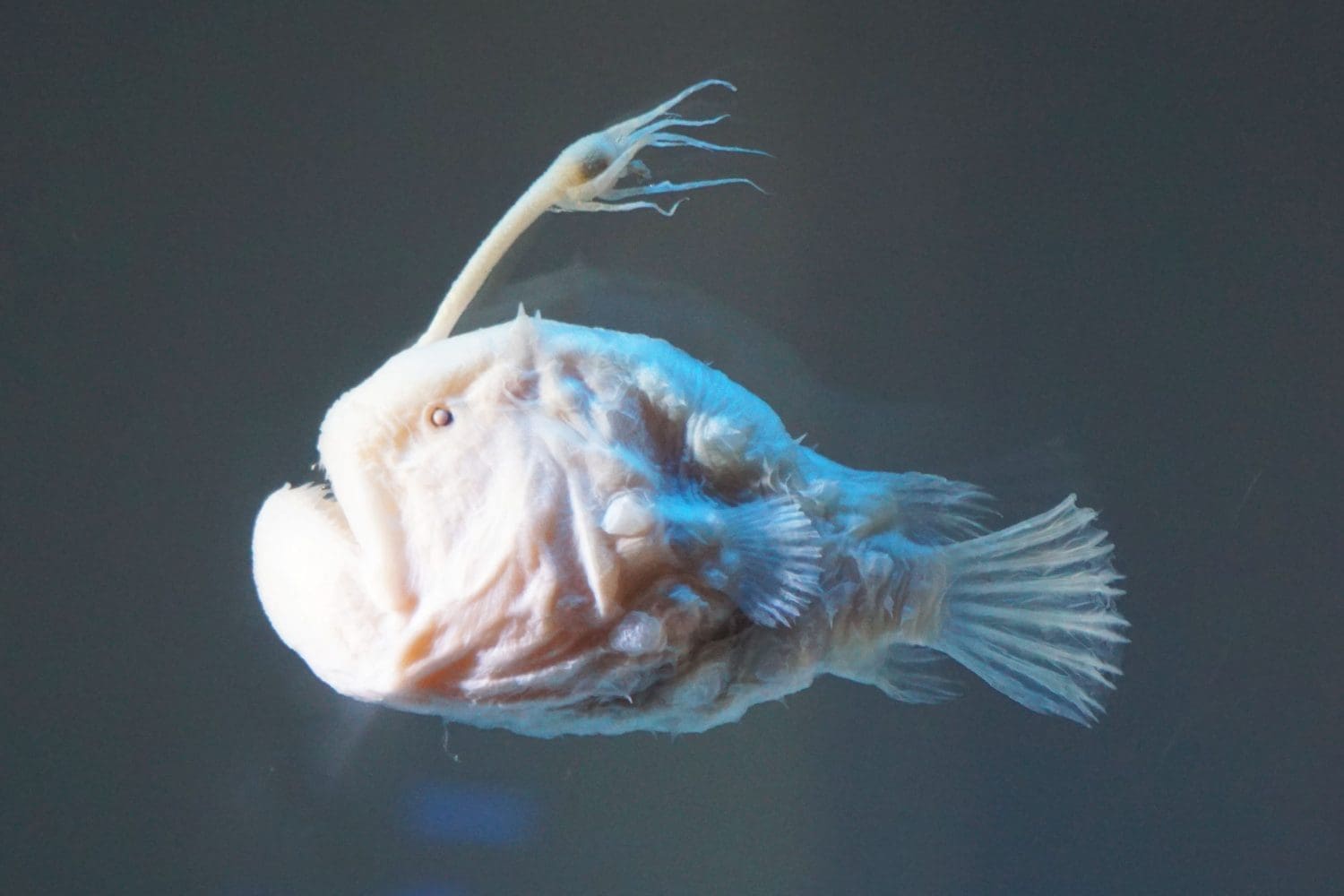
The
anglerfish
carries about its fishing rod and lure on its head!
©panparinda/Shutterstock.com
The anglerfish (Chaenophryne quasiramifera) may be the most frightening-looking fish in the oceans, even though it’s usually only 1 – 4 feet long. A few anglerfish species live in shallow waters, but most are found in the ocean’s deepest, darkest waters where bioluminescence helps them hunt. On the anglerfish’s head is a rod featuring a glowing, microbes-filled tip. The anglerfish moves this bright “lure” around to attract prey, then grabs it quickly for dinner.
15. Frilled Shark
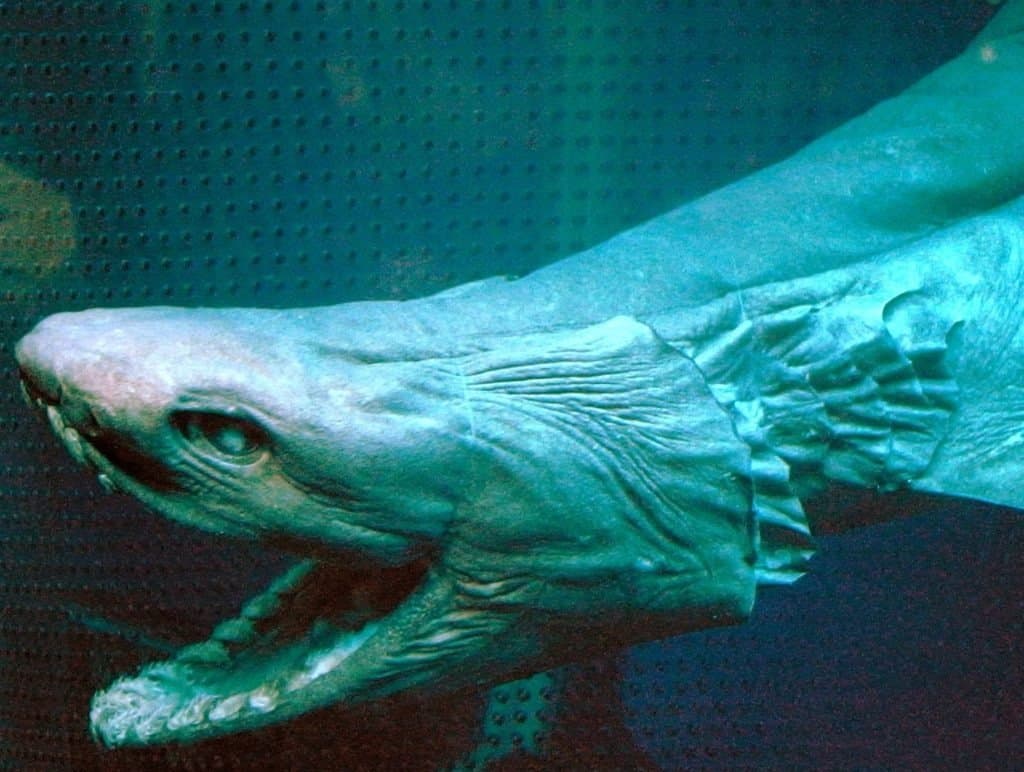
The
frilled shark
looks like a lizard-alien hybrid with its multiple layers of frills and full mouth of teeth!
©OpenCage / CC BY-SA 2.5 – License
A rare and prehistoric shark unlike any shark you’ve seen is the frilled shark (Chlamydoselachus anguineus). Its 300 sharp, three-pronged teeth are set in dozens of rows, and feature 1,000 little hooks so it can grab its prey. Ruffly gills give this scary thing a strange frilled-neck appearance. The head of the frilled shark looks almost like a lizard, and its long body could be mistaken for the body of an eel. Almost everyone would agree, the frilled shark most definitely is one of the scariest things still lurking in the ocean today.
16. Vampire Squid

The vampire squid is indeed a frightening creature that can provoke nightmares! That’s why it’s one of the scariest things still lurking in the ocean today.
©Emőke Dénes / CC BY-SA 4.0, via Wikimedia Commons – License
The odd-looking vampire squid (Vampyroteuthis infernalis) is not a squid or an octopus, but rather a cephalopod growing to the size of a football. Reminiscent of a vampire, this deep ocean-lurking beast uses its arms like a cape to wrap them around its body. Another vampire-esque feature: its blood-red skin color! More strange attributes include large eyes that can appear bright blue and spine-like protrusions on its eight tentacles.
Amazingly, to avoid predators this unique animal turns its body inside out to keep its light-emitting organs (“photophores”) and itself invisible.
17. Ocean Whirlpools

The largest whirlpool in the world swirls viciously in waters located off Norway. It has existed for over 3,000 years!
©olrat/Shutterstock.com
Ocean whirlpools are terrifying natural phenomena identified by erratic, rotating waters made by fast-flowing tides and currents moving in two different directions. Since they easily can suck down people and boats of all sizes deep within their watery throats, it’s best to avoid these vortexes at all costs!
A small whirlpool is an “eddy,” while a larger, more dangerous one is a “maelstrom.” Some whirlpools have existed for hundreds, if not thousands, of years. In 2017, scientists discovered large twin whirlpools (“modons”) in the ocean. Twirling in opposite directions but next to each other, they travel in tandem up to 10 times faster than a normal ocean eddy.
18. Giant Squid
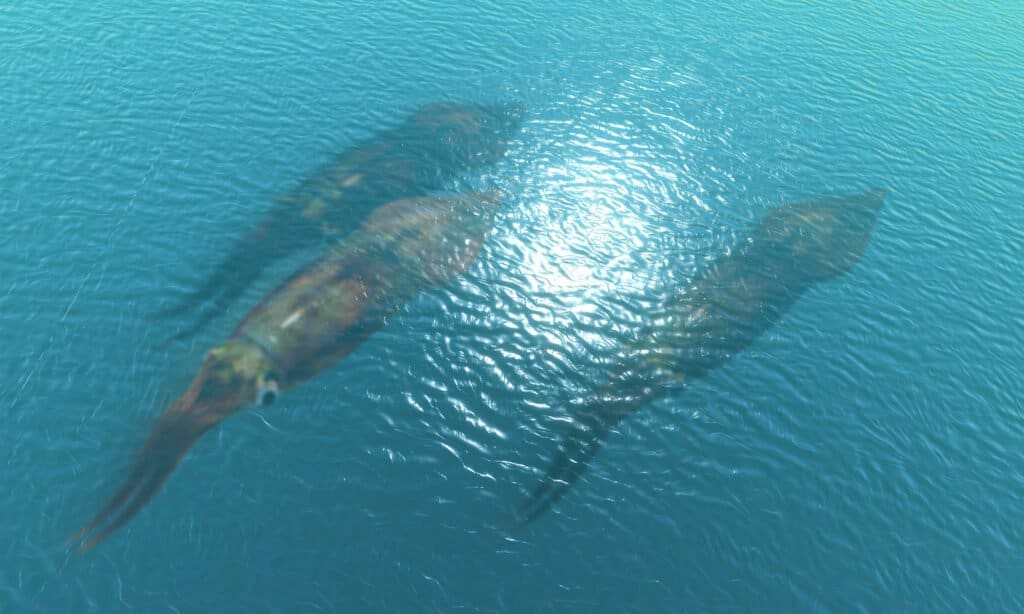
“Normal-size” giant squids can weigh up to 600 pounds! Their size is what makes them scary.
©Jiri Flogel/Shutterstock.com
The giant squid (Architeuthis dux) reigns as the largest and fastest-swimming invertebrate on our planet. Yes, it’s the closest real animal to the mythical Kraken. Generally, a giant squid is 35 – 43 feet long. However, a few giants measure 59 feet in length (about the stretch of a bowling lane). Amazingly, the largest ones can weigh 2,000 pounds; twice the weight of most specimens.
Until very recently, all attempts to get good images of this elusive scary creature in its habitat failed. Yet in 2002, scientists took the first photo of a living giant squid deep in the ocean. A decade later in 2012, researchers made the first video of a giant squid 2,000 feet below waters off Japan’s coast. Then in 2019, they captured a giant squid on video for the first time in U.S. waters (Gulf of Mexico).
19. Flesh-Eating Bacteria

Photo of tiny bacteria. Most often it’s the scary
Vibrio vulnificusocean-dwelling bacteria species that causes flesh-eating disease!
©cones/Shutterstock.com
Another scary thing lurking in the ocean today you can’t see with the naked eye: flesh-eating bacteria! When ocean waters are warmest, from May to October, flesh-eating bacteria can enter a person’s body via a cut, scrape, or insect bite. If not caught early, the bacteria can develop into Necrotizing Fasciitis, a flesh-eating disease. It destroys tissues everywhere in the body, and often makes a victim’s organs fail. About 200 Americans get this infection each year. Sadly, about 20 percent of them die from it, typically within two days.
Doctors prescribe antibiotics through an IV or in a pill to kill flesh-eating bacteria and stop them from spreading. Unfortunately, sometimes antibiotics don’t work. In those cases, limbs can be amputated or infected organs and flesh can be cut out to save a life. Be aware that even oysters can carry dangerous flesh-eating bacteria!
20. Ocean Graveyards

Underwater shipwrecks, like the famous one in Micronesia, still have value at the ocean’s bottom. They serve as homes for countless fish and become ideal diving destinations.
©Kichigin/Shutterstock.com
What’s more scary than an eerie cemetery? Probably an underwater graveyard of military equipment and the resting place of fighting men. One of the most famous is an ocean graveyard, possibly haunted, located 50 feet in the waters of Micronesia’s Chuuk Lagoon.
The wreckage got there during a 1944 battle between Japanese and American forces. The broken pieces are what’s left from over 60 ships, railroad cars, tanks, and planes that sank here. Today, the lagoon is popular with scuba divers desiring to see authentic WW2 military artifacts up close.
We hope you had fun reviewing 20 of the scariest things still lurking in the ocean today! Don’t let them stop you from exploring the shallow and deep waters of our beautiful planet wherever you wander. They’re all important in the wonderful natural world!
The photo featured at the top of this post is © Neil Bromhall/Shutterstock.com
Thank you for reading! Have some feedback for us? Contact the AZ Animals editorial team.






